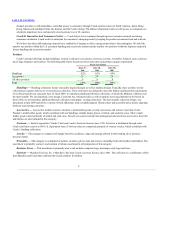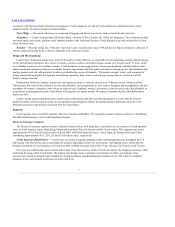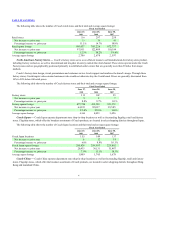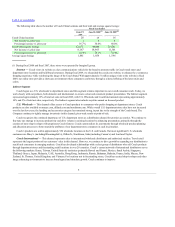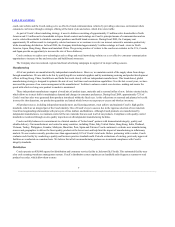Coach 2008 Annual Report Download - page 14
Download and view the complete annual report
Please find page 14 of the 2008 Coach annual report below. You can navigate through the pages in the report by either clicking on the pages listed below, or by using the keyword search tool below to find specific information within the annual report.
TABLE OF CONTENTS
Demand for our products is significantly impacted by negative trends in consumer confidence and other economic factors affecting
consumer spending behavior. The downturn in the economy may continue to affect consumer purchases of our products for the foreseeable
future and adversely impact our results of operations.
The growth of our business depends on the successful execution of our growth strategies.
Our growth depends on the continued success of existing products, as well as the successful design and introduction of new products.
Our ability to create new products and to sustain existing products is affected by whether we can successfully anticipate and respond to
consumer preferences and fashion trends. The failure to develop and launch successful new products could hinder the growth of our
business. Also, any delay in the development or launch of a new product could result in our not being the first to market, which could
compromise our competitive position.
Significant competition in our industry could adversely affect our business.
We face intense competition in the product lines and markets in which we operate. Our competitors are European luxury brands as well
as private label retailers, including some of Coach’s wholesale customers. There is a risk that our competitors may develop new products
that are more popular with our customers. We may be unable to anticipate the timing and scale of such product introductions by
competitors, which could harm our business. Our ability to compete also depends on the strength of our brand, whether we can attract and
retain key talent, and our ability to protect our trademarks and design patents. A failure to compete effectively could adversely affect our
growth and profitability.
We face risks associated with operating in international markets.
We operate on a global basis, with approximately 28% of our net sales coming from operations outside the U.S. However, sales to our
international wholesale customers are denominated in U.S. dollars. While geographic diversity helps to reduce the Company’s exposure to
risks in any one country, we are subject to risks associated with international operations, including, but not limited to:
•changes in exchange rates for foreign currencies, which may adversely affect the retail prices of our products, result in decreased
international consumer demand, or increase our supply costs in those markets, with a corresponding negative impact on our gross
margin rates,
•political or economic instability or changing macroeconomic conditions in our major markets, and
•changes in foreign or domestic legal and regulatory requirements resulting in the imposition of new or more onerous trade
restrictions, tariffs, embargoes, exchange or other government controls.
To minimize the impact on earnings of foreign currency rate movements, we monitor our foreign currency exposure in Japan through
foreign currency hedging of Coach Japan’s U.S. dollar-denominated inventory purchases. We cannot ensure, however, that these hedges will
succeed in offsetting any negative impact of foreign currency rate movements.
A downturn in the economy could affect consumer purchases of luxury items and adversely affect our business.
Many factors affect the level of consumer spending in the premium handbag and accessories market, including, among others, general
business conditions, interest rates, the availability of consumer credit, taxation and consumer confidence in future economic conditions.
Consumer purchases of discretionary luxury items, such as Coach products, tend to decline during recessionary periods, when disposable
income is lower. A downturn in the economies in which Coach sells its products may adversely affect Coach’s sales.
Our business is subject to the risks inherent in global sourcing activities.
As a company engaged in sourcing on a global scale, we are subject to the risks inherent in such activities, including, but not limited to:
•availability of raw materials,
•compliance with labor laws and other foreign governmental regulations,
10




